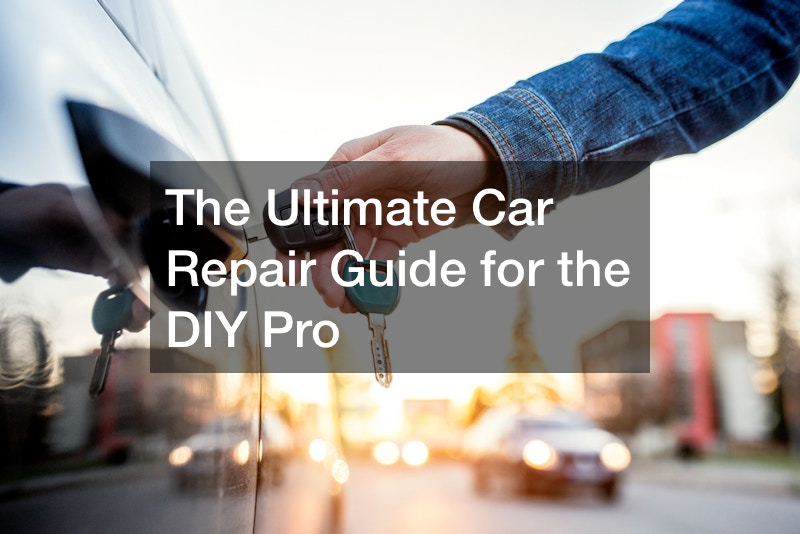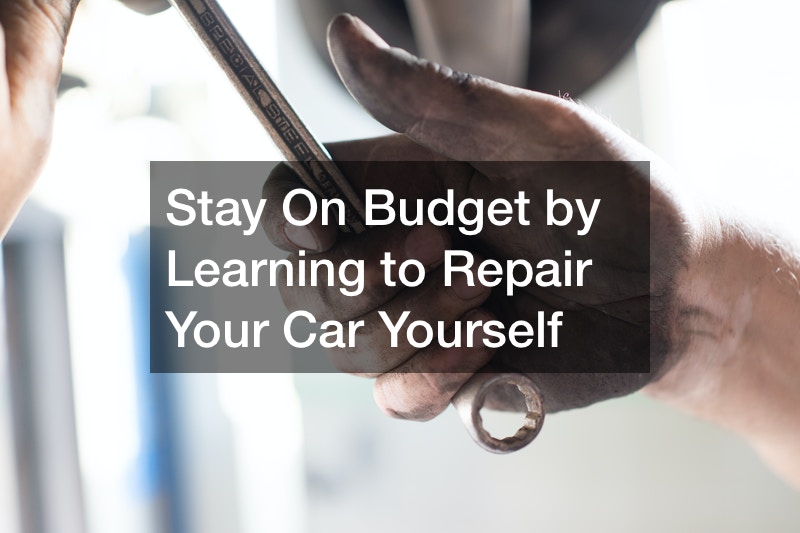
The Ultimate Car Repair Guide for the DIY Pro

A car costs among your priced investment, and you want to keep it in mint condition by repairing it as soon as you notice a problem. However, repairs can be expensive, and the costs can add up quickly, draining your wallet. According to AAA, the average cost of repairing most common car issues ranges from $500 to $600. You wish to avoid such costs and still have your vehicle run properly.
This ultimate car repair guide comes to your rescue. It will teach you how to diagnose and fix common car problems by yourself, enabling you to avoid some costly repairs. Without further ado, let’s get started.
Headlight Replacement

Our first ultimate car repair is replacing faulty headlights. Headlights are crucial for safe nighttime driving, visibility, and hazard recognition. However, over time, they may degrade, necessitating replacement. You can easily identify the need for replacement when you notice reduced brightness, dim/flickering lights, or burnt-out bulbs. According to Forbes, these signs manifest as early as three years after they’re installed but are more evident after five years.
The signs should warn you to replace the bulb sooner before you cause accidents that would leave you in court desperately needing the help of injury attorneys. Begin by identifying the malfunctioning bulb and get the right replacement – you can check the car’s user manual and buy from trusted auto spares. Next, open the hood and find the back of the headlight assembly. You may have to remove some parts to access it. Once accessed, disconnect the electrical connector and twist the old bulb out of the socket.
Do not touch the glass part of the new bulb with your fingers to avoid tampering with its functioning. Insert it into the socket and twist it until it’s secure. Reconnect the electrical connector to the bulb. Make sure it’s aligned and fitted well. Do the same for the other bulb if need be. Close the hood and reconnect the battery cable. Turn on your headlights and test them. Ascertain they’re working optimally, and you’ll be good to go.
Air Conditioning Repair
The air conditioning (AC) system keeps you cool and comfortable on the road. That’s why fixing the AC ranks top on our ultimate car repair guide. The system can malfunction due to various reasons. The first one is low refrigerant characterized by warm or inconsistent air. You can confirm the problem using a gauge to check the refrigerant pressure and compare it to the recommended level. If low, recharge it using a kit.
Intermittent or lack of power to the AC unit is also a telltale sign of a problem. Check to confirm all connections are secure and wires aren’t exposed. Otherwise, tighten connections or use electrical tape for insulation repairs.
Here is a secret. You can avoid frequent AC repair if you use it sparingly or when necessary. It helps keep it in good condition and saves on fuel consumption. According to Fuel Economy and EPA, AC can reduce vehicle fuel economy by 25%.
Interior Cleaning
If you’re a firewood supplier or often transport goods, your car’s interior can suffer from wood chips, dirt, and debris, making your drive less enjoyable and accelerating wear and tear. This ultimate car repair guide teaches you how to perform regular interior cleaning to prevent these issues.
Start by removing trash or clutter from your car, such as wrappers, bottles, and papers. You can use a trash bag or a bin to collect them. Then, vacuum the seats, carpets, and floor mats to remove dust, dirt, crumbs, and other debris. You can use a handheld vacuum or a regular vacuum with attachments. Don’t forget to vacuum under the seats and between the cracks.
Finally, if your car has leather seats, condition them with a leather cleaner and conditioner suitable for your car’s leather type and color. Apply the cleaner with a microfiber cloth and rub it gently on the seats. Then, apply the conditioner with another cloth and let it dry.
Windshield Cleaning

Your windshield is among the most critical parts of your car as it gives you an unobstructed view by protecting you from the elements and airborne particles. You should ensure it’s always clean to get the most from it. A dirty windshield can obstruct your view of the road, much like dirty eyeglasses can obstruct your vision. Driving with an obstructed view is dangerous as it can result in accidents. You want to avoid this, and yes, this ultimate car repair guide explains it all.
You’ll need a microfiber cloth, glass cleaner, and water to start. Mix the glass cleaner with water in a bucket, following the given instructions for the correct ratio. Dip the microfiber cloth into the solution and wring it thoroughly to avoid excess water.
Then, use the damp microfiber cloth to wipe down the windshield, starting from the top and working your way down. Be sure to wipe in straight lines to avoid creating streaks or smears. Use a soft-bristled brush to scrub gently if there are any stubborn spots or stains. Finally, use a clean, dry microfiber cloth to dry the windshield.
Body Dent Repair
Dents can be an eyesore and significantly reduce your vehicle’s resale value. According to Jerry Insurance, a dent or a scratch on the paint that is visible from 10 feet away can lower your car’s value by 5% to 10%. Therefore, fixing a dent is an ultimate car repair you must prioritize. Fortunately, there are various ways to fix the problem, depending on their size and location.
A dent puller tool may be necessary for slightly larger dents. This tool has a flat steel pad placed against the dent and a handle pulled, pressing the pad against the dent and pushing it out. This method requires more force than the suction cup method but is still relatively easy to use and can be effective for dents about the size of a golf ball. You might need a stud welder if the dent is too significant for the above methods. This device uses an electrical current to heat a metal stud, which pushes the dent out.
Pest Removal
Pests like rodents, insects, and birds can damage your car. For instance, rodents chew on wires and materials, causing costly repairs. Insects build nests in the engine compartment, clogging parts and causing malfunctions, while birds leave droppings that etch the paint and damage the finish.
To avoid all these inconveniences, you want to eliminate pests once and for all. But how do you go about it? This depends on what type of pest you are dealing with.
You can eliminate rodents by removing food leftovers and covering your vehicle with a tarp or using specially designed rodent repellents around your parking area. You can also trap the pests. In the case of insects, use insecticides specifically formulated for cars to kill and repel insects. Apply these insecticides into crevices and areas where insects gather, like the engine compartment.
Similarly, you can deter birds by parking your car in a covered area or using a car cover when indoor parking isn’t possible. For added protection, you may install a bird deterrent system, such as a motion-activated sprinkler, to discourage birds from approaching your vehicle. If the pest issue persists, enlist a local exterminator for help!
Paint Touch-Ups

In the same way your property fencing needs touch-ups to restore its appearance and protect it from corrosion, your car also requires paint touch-ups for similar reasons and to add value. To perform a paint touch-up, clean the affected area and remove any loose paint or rust. Apply a primer to the exposed metal to prevent corrosion.
Select a touch-up paint that matches your car’s color and apply it using a small brush or applicator. Allow it to dry according to the manufacturer’s instructions. Once the paint is dry, carefully polish the restored area using a rubbing compound to blend with the surrounding paint, making the repair less noticeable.
After the touch-up, ensure you care for the car and do proper maintenance to avoid damage, chipping and corrosion. For instance, consider fencing the car parking bay. Alternatively, park the car in an enclosed area such as the garage.
Tire Replacement
The next thing on our ultimate car repair is replacing the tires. Tires are vital for your vehicle’s safety and performance, providing traction, stability, and control. However, they gradually wear down over time due to road conditions, mileage, and driving habits. When worn or damaged, they lose their ability to grip asphalt paving, compromising safety and performance.
To ensure safe driving, replacing tires when the tread depth reaches 2/32 of an inch or less is crucial. This can be done quickly and easily with the right tools and knowledge. First, ensure you have a spare tire, carjack, lug wrench, and tire pressure gauge.
To begin, loosen the lug nuts on the flat tire using the lug wrench. Raise the vehicle using the carjack until the flat tire clears the ground. Then, remove the lug nuts and take off the flat tire. Next, fit the spare tire onto the wheel hub and hand-tighten the lug nuts.
Now, lower the vehicle back down and use the lug wrench to tighten the lug nuts as tight as possible in a star pattern. Finally, check the tire pressure in the new tire and add air if necessary. Ensuring the spare tire is inflated correctly for your safety on the road is vital. Consider professional asphalt paving if your pavements are worn out to reduce wheel problems.
Spark Plug Replacement
Spark plugs ignite the fuel-air mixture in your engine, generating power. They can wear out or get dirty over time, necessitating replacements. Luckily, this ultimate car repair guide will help you manage.
All you need is a spark plug socket, a ratchet, an extension, a gap tool, and new plugs. Once you have these in place, find the plugs in your engine and remove the wires from them individually. Loosen and remove the old plugs with the socket and the ratchet. Inspect them for wear or damage.
The next thing is to check and adjust the gap of the new plugs with the gap tool. The gap is the distance between the tip and the arm of the plug. The proper gap size is in your manual or on a sticker under the hood.
Install the new plugs by hand and tighten them gently. Do not over-tighten or use a wrench. You can use an anti-seize compound on the threads. Once done, reattach the wires to the new plugs and make sure they fit well. Do this for each plug and dispose of the old plugs properly. While replacing spark plugs is among the exacting tasks that require auto repair services, you can get the job done.
Wiper Fluid Refill

Wiper fluid is vital for driving safely in bad weather. It cleans the dirt and bugs on your windshield that may block your view. However, wiper fluid depletes over time, so you must check and refill it regularly.
You can tell if your car needs more wiper fluid by looking for a low fluid indicator or a warning light on your dashboard. You might also notice that the wiper fluid spray is weak or uneven, and the windshield isn’t getting clean enough. If you see these telltale signs, include a wiper fluid refill in your ultimate car repair checklist.
First, purchase the correct fluid type for your car. You can find this information in your owner’s manual. Then, locate the wiper fluid reservoir under the hood of your car. It’s usually on the driver’s side. Open the cap and pour the new fluid into the reservoir slowly. Don’t overfill it, as this can damage the system.
After adding the fluid, close the cap and test the wipers. They should work properly and spread the fluid evenly across the windshield. If they don’t, you may need to replace the wiper blades to see if that helps. If the problem persists, visit your local auto repair center.
By mastering the skills outlined in this ultimate car repair guide, you can significantly reduce expenses, prolong your vehicle’s lifespan, and enhance the safety and pleasure of your driving experience. Refer to your car’s owner’s manual for precise guidance, and don’t hesitate to enlist professional assistance when necessary. Does your car problem recur after trying DIY methods? Drop by our shop today for expert guidance and a free quote.


